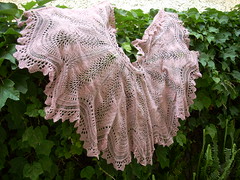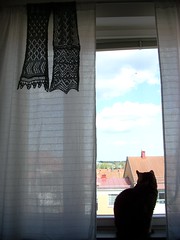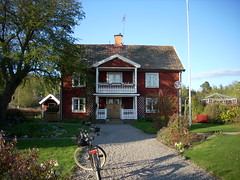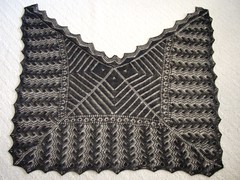Yesterday I surprised myself by finishing two projects, a fichu cast on last week and a scarf cast on last year; this made me think about what makes some things quick to knit and others slow.
Obviously, it’s a question of motivation – but in my case it doesn't seem to have much to do with level of difficulty. The scarf certainly wasn’t more difficult to knit, on the contrary. My sister chose the yarn and we agreed I’d knit a scarf with various patterns: she liked the idea of a scarf with a lot of variation in it, and I liked the idea of being able to test different lace patterns. Therefore, I really should have been able to finish it ages ago.
 "The Opera Fichu" by Jane Sowerby, on the other hand, is a different kind of garment that I haven’t knitted before. You begin by knitting a rectangle, then pick up stitches around it to knit a border, fold it, pick up stitches and cast on new ones to knit a neckband and ties.
"The Opera Fichu" by Jane Sowerby, on the other hand, is a different kind of garment that I haven’t knitted before. You begin by knitting a rectangle, then pick up stitches around it to knit a border, fold it, pick up stitches and cast on new ones to knit a neckband and ties.
It was far less complicated than I expected from the photos of the finished garment, but still very enjoyable learning how to knit it.
What is time-consuming about the fichu is the number of stitches: a border row consists of more than a thousand stitches, which is something of a paradox considering it’s a fairly small garment. However, the border pattern isn't very difficult; a repeat is six stitches wide and consists of two rows, one of which is knits only. I must admit it was rather monotonous, but then it didn't require much concentration so I could knit it even when it was getting late and I was getting tired.
What, then, is important for me to really get into a project? These seem to be the main factors:
- A plan. Not necessarily knowing all the details but a general idea about the construction of the garment and what it will look like. You could say I like having a plan that I can change if I want to. (I did change some things in the fichu pattern, but let's not go down that road right now...) Perhaps the scarf idea was too vague: knit different patterns until you run out of yarn or it is long enough. Well, at least it seemed like a good idea in September.
- Variation is important. Why then do I complain about a scarf that practically consists of variation? A strong sense of democracy: only a few lines above I complained about how monotonous the fichu border was, so in all fairness it's my duty to find fault with the scarf. I'm probably too much of a control freak: I like controlled variation, knowing the different elements will blend well. Perhaps you could compare it to colours. I don't mix all the colours and shades of colours I like in the same garment, but combine the ones I believe look good together.
- Developing my skills by learning new things, testing ideas and stretching my limits - that's both exciting and rewarding. And I did get to test patterns making the scarf.
- My personal taste. Call me selfish – I do! – but in my opinion life is simply too short for me to knit things I'm not that fond of.
Now, the scarf was a good project, worth knitting not just because I learnt more about myself as a knitter, but because my sister is pleased with the results. That's an important factor too, of course. But can you use the scarf to dress up as Rasputin, which is possible with the fichu?










.JPG)
